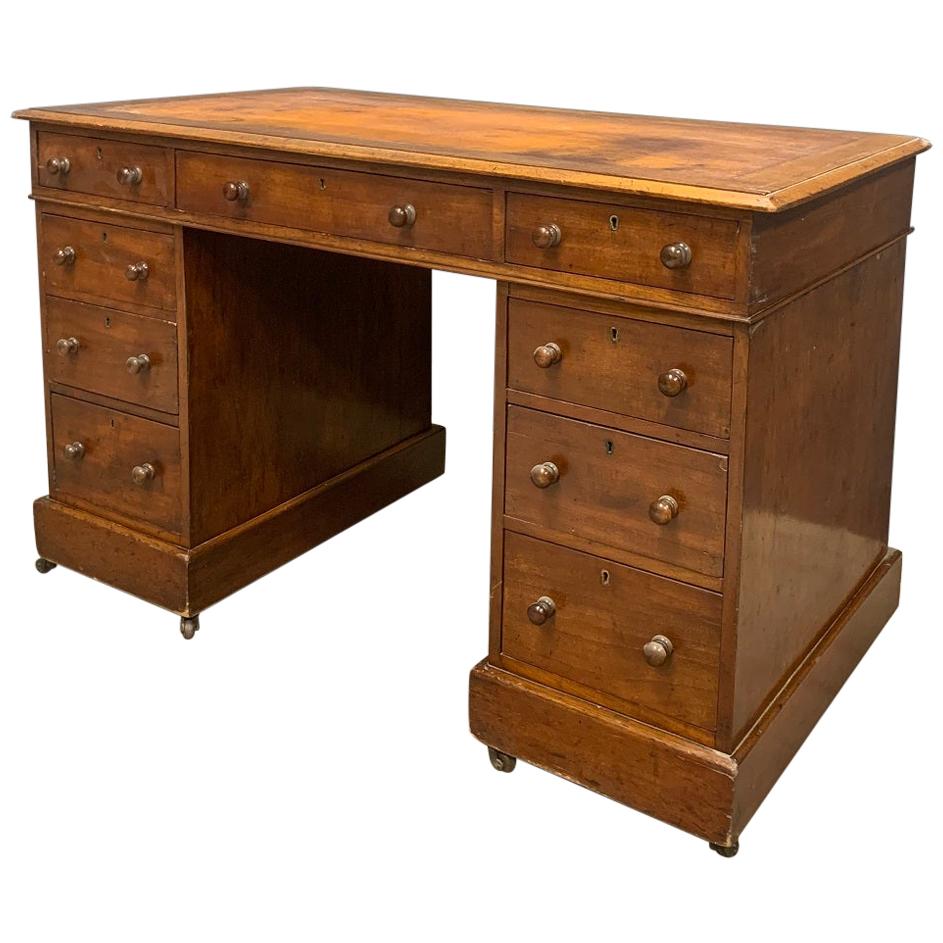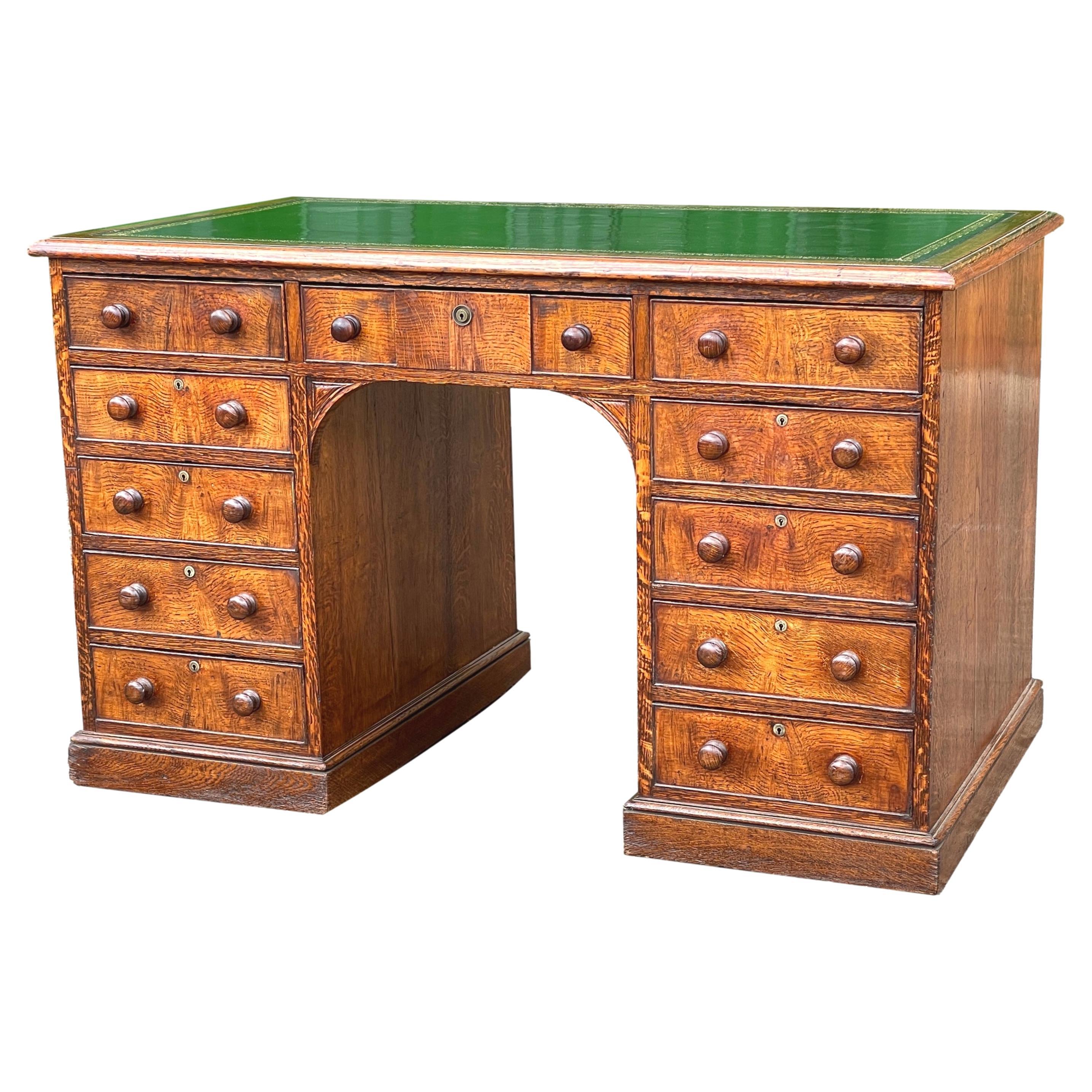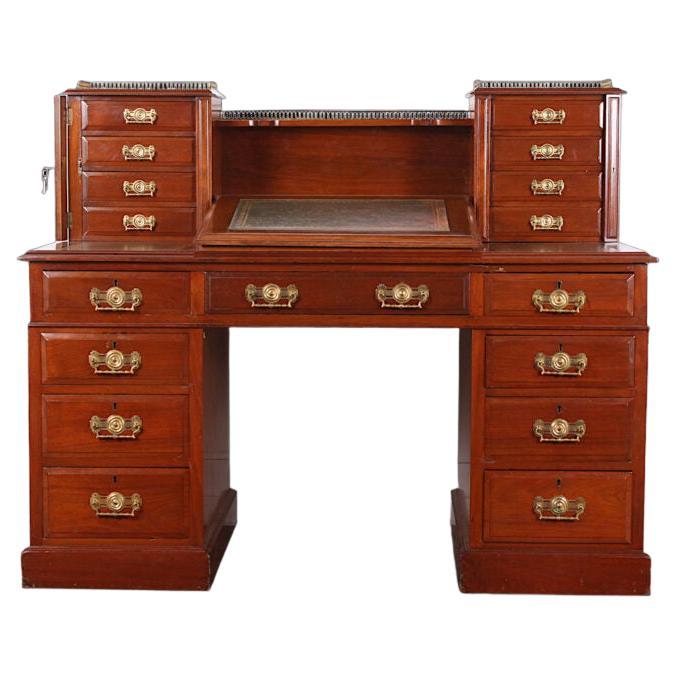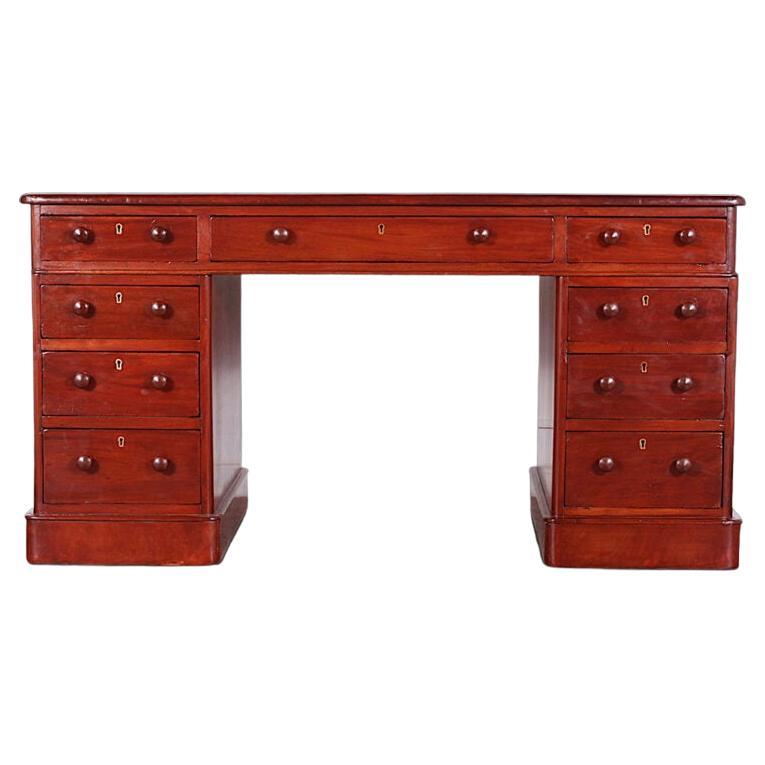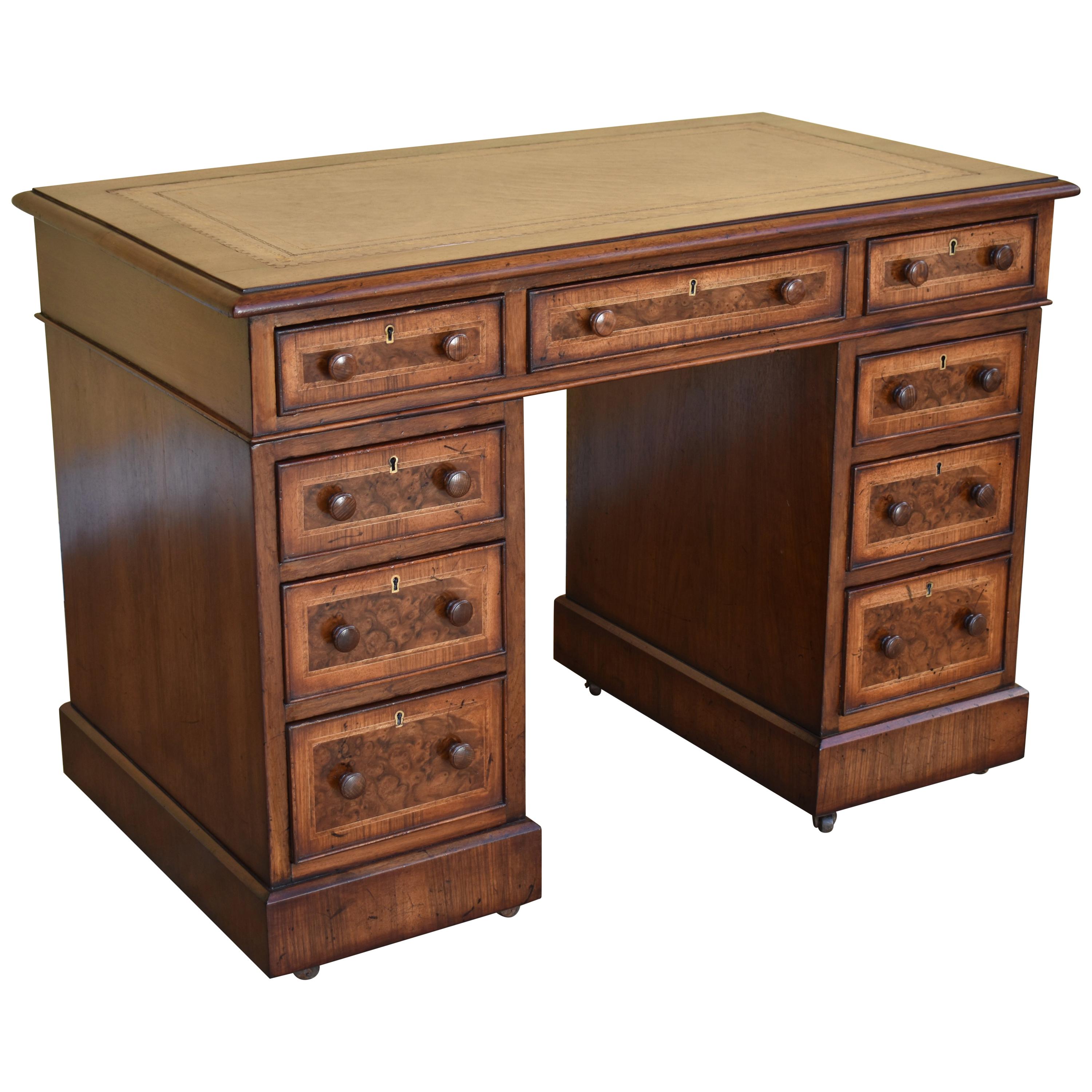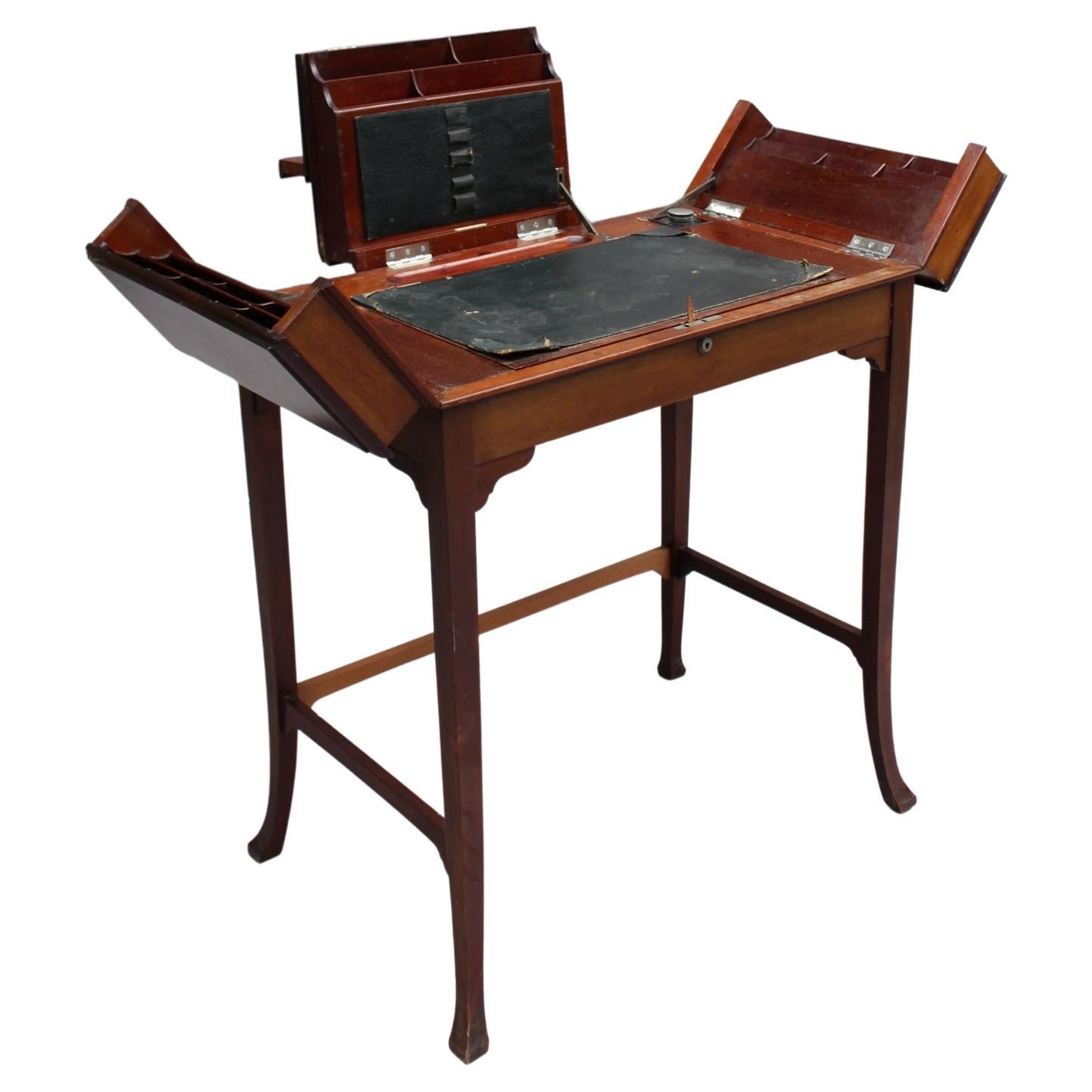Items Similar to Rare 19th Century English Eclipse Patented Telescopic Desk
Want more images or videos?
Request additional images or videos from the seller
1 of 21
Rare 19th Century English Eclipse Patented Telescopic Desk
About the Item
Presenting an exceptionally rare 19th century English eclipse patented telescopic desk.
Made of oak in the Rococo style in Great Britain, circa 1880.
Fully marked as “The Eclipse” … Brand’s Patent No 27871 … Patented in Great Britain.
Marked on the brass lever mechanism on all 4 levers.
This desk is gorgeous!
It sits on 4 brass casters with bulbous feet and cabriolet legs. When closed it appears like a simple but attractive side table. The top is edged with brass corners which perfectly compliment the piece.
When you turn the key that is when the magic happens. The 2 lids open outwards on decorative brass levers and the central desk sections lifts from the center of the table as you open it on a telescopic mechanism.
Fully open you reveal a stunning and practical desk, with a red Moroccan leather central section which functions just like a lap desk with a storage compartment underneath.
Above it is a gallery area for stationary, pens etc with 2 inkwells.
On the left side of the desk is a red Moroccan and gilt bordered leather pouch area for diary purposes with the original insert for “Engagements” and ‘Memoranda”.
On the right side you have a red Moroccan and gilt bordered leather pouch area for pens.
The brass work is fabulous throughout.
We dare you to find another!!
The Rococo Revival style emerged in Second Empire France and then was adapted in England. Revival of the rococo style was seen all throughout Europe during the 19th century within a variety of artistic modes and expression including decorative objects of art, paintings, art prints, furniture, and interior design. In much of Europe and particularly in France, the original rococo was regarded as a national style, and to many, its reemergence recalled national tradition. Rococo revival epitomized grandeur and luxury in European style and was another expression of 19th century romanticism and the growing interest and fascination with natural landscape.
During the later half of the 19th century, Rococo Revival was also fashionable in American furniture and interior design. John Henry Belter was considered the most prominent figure of rococo revival furniture making. Revival of the rococo style was not restricted to a specific time period or place, but occurred in several waves throughout the 19th century.
Provenance: From a Dallas Estate.
Condition: Very good. The casters are contemporary replacements but in the correct style and the brass appliques to the top are of recent application. The locking mechanism is ‘tricky’ but works. The 3 brass pens are included, but are modern. One of the inkwells is a replacement (the one on the right). Otherwise it is excellent. Some minor blemishes through use and age.
Dimensions: 31.25 inches tall, 23 inches wide and 24.5 inches deep (Closed)
Fully open it is 45 inches wide, 35 inches tall and 24.5 inches deep.
- Dimensions:Height: 31.25 in (79.38 cm)Width: 23 in (58.42 cm)Depth: 24.5 in (62.23 cm)
- Style:Late Victorian (Of the Period)
- Materials and Techniques:
- Place of Origin:
- Period:
- Date of Manufacture:1880
- Condition:Wear consistent with age and use. See listing for full condition report.
- Seller Location:Dallas, TX
- Reference Number:1stDibs: LU3978121215562
About the Seller
4.9
Platinum Seller
These expertly vetted sellers are 1stDibs' most experienced sellers and are rated highest by our customers.
Established in 2015
1stDibs seller since 2018
349 sales on 1stDibs
Typical response time: <1 hour
- ShippingRetrieving quote...Ships From: Dallas, TX
- Return PolicyA return for this item may be initiated within 7 days of delivery.
More From This SellerView All
- 19th Century Standard Grade Wooton DeskBy Wooton Desk Co.Located in Dallas, TXPresenting a highly desirable and quite rare 19th century standard grade Wooton desk. This desk was made in Indiana, circa 1880 by the Wooton Desk Co. Made of walnut and burled walnut. Black cast iron hardware. Fully marked. In the Gallery we have excepts from the Smithsonian Institution publication concerning the history of “The King of Desks ….Wooten Patent Secretary” by Betty Lawson Walters (a copy of which will be furnished with the desk upon purchase). Wooten Desks...Category
Antique Late 19th Century American Late Victorian Desks
MaterialsWalnut
- 19th Century Hampton & Sons Chinese Chippendale Cylinder DeskBy Thomas ChippendaleLocated in Dallas, TXPresenting an absolutely gorgeous mid-late 19th century British Chinese Chippendale style cylinder desk from the renowned maker of Hampton & Sons, of Pall Mall, London. This stunnin...Category
Antique Late 19th Century English Chinese Chippendale Desks
MaterialsMahogany
- 19th Century American Cutler & Sons Model 1 Roll Top DeskLocated in Dallas, TXPresenting a glorious piece of Americana namely, a 19th century American Cutler & Sons model 1 roll top desk. This is the prototype of the well-known Cutler & Sons patented desk...Category
Antique Late 19th Century American American Craftsman Desks
MaterialsWalnut
- Early 19th Century British Davenport Desk in the Manner of GillowsLocated in Dallas, TXPRESENTING AN ABSOLUTELY STUNNING Early 19C British Rosewood Davenport Desk in the Manner of Gillows circa 1830. A Davenport is a type of writ...Category
Antique Early 19th Century English William IV Desks and Writing Tables
MaterialsHardwood
- 19th Century Irish Country Squire's Oak Telescopic Dining TableLocated in Dallas, TXFrom circa 1860, five beautifully turned baluster legs on brass castors, beautiful oak patina on top with a high gloss finish. It is very rare to find one of these made of solid oak...Category
Antique Mid-19th Century Irish High Victorian Dining Room Tables
MaterialsOak
- Rare 19th Century English Tunbridgeware Hair Pin or SlideLocated in Dallas, TXPresenting an absolutely gorgeous and extremely unique and rare 19th century British Tunbridgeware hair pin/bobbin or slide. This slide is unlike any of it’s kind we have seen before…. it is a very rare survivor ! From circa 1860–1880. Made of walnut with gorgeous marquetry inlay on the entirety of the front with classic Tunbridgeware micro-mosaic all over the front. The rear is walnut. The marquetry inlay appears to be various different woods, namely, maple, walnut and satinwood. Would have been worn in a Lady’s hair bun with the micro-mosaic facing forward. This would have belonged to a very elegant lady in the mid to late 19th century. Tunbridge ware is a form of decoratively inlaid woodwork, typically in the form of boxes, that is characteristic of Tonbridge and the spa town of Royal Tunbridge Wells in Kent in the 18th and 19th centuries. The decoration typically consists of a mosaic of many very small pieces of different coloured woods that form a pictorial vignette. Shaped rods and slivers of wood were first carefully glued together, then cut into many thin slices of identical pictorial veneer with a fine saw. Elaborately striped and feathered bandings for framing were pre-formed in a similar fashion. There is a collection of Tunbridge ware in the Tunbridge Wells Museum and Art Gallery in Tunbridge Wells. The famous makers of Tunbridge ware were in the Tunbridge Wells area of Kent; their most notable work was from circa 1830-1900. Early makers of Tunbridge ware, in Tunbridge Wells in the mid-18th century, were the Burrows family, and Fenner and Co. In the 19th century, around 1830, James Burrows invented a technique of creating mosaics from wooden tesserae. Henry Hollamby, apprenticed to the Burrows family, set up on his own in 1842 and became an important manufacturer of Tunbridge ware, employing about 40 people. Edmund Nye (1797–1863) and his father took over the Fenner company when William Fenner retired in 1840, after 30 years in partnership with him. Thomas Barton (1819–1903), previously apprenticed at the Wise factory, joined the Nyes in 1836, and worked as Nye’s designer; he took over the business in 1863 and continued there until his death. In Tonbridge (near to Tunbridge Wells), George Wise (1703–1779) is known to have had a business in 1746. It continued with his son Thomas, and Thomas’s nephew George (1779–1869), who took over in 1806. In its early years the company made articles such as workboxes and tea caddies with prints of popular views; later items had pictures created from mosaics. Their workshop in Tonbridge, Wise’s Tunbridge Ware Manufactory, was next to the Big Bridge over the Medway; the building was demolished in 1886 to widen the approach to the bridge. Tunbridge ware became popular with visitors to the spa town of Tunbridge Wells, who bought them as souvenirs and gifts. Articles included cribbage boards, paperweights, writing slopes, snuffboxes and glove boxes. At the Great Exhibition of 1851, Tunbridge ware by Edmund Nye, Robert Russell and Henry Hollamby was shown; Edmund Nye received a commendation from the judges for his work. He exhibited a table depicting a mosaic of a ship at sea; 110,800 tesserae were used in making the picture. The manufacturers of Tunbridge ware were cottage industries, and they were no more than nine in Tunbridge Wells and one in Tonbridge. The number declined in the 1880s; competent craftsmen were hard to find, and public tastes changed. After the death of Thomas Barton in 1903 the only surviving firm was Boyce, Brown and Kemp, which closed in 1927. Marquetry was an old technique which was continued by Nye and Barton to create images such as birds or butterflies. ‘Green Oak’ as caused by the fungus Chlorociboria aeruginascens. Stickware and half-square mosaic was invented by James Burrows in about 1830: a bunch of wooden sticks of different colours, each having triangular or diamond-shaped cross section, were tightly glued together; in the case of stickware, the resulting block was dried, then turned to form an article such as the base of a pincushion. For half-square mosaic, thin slices were taken from the composite block, and applied to a surface.[1][2][4] Tesselated mosaic, was a development by James Burrows of half-square mosaic; it was adopted by George Wise and Edmund Nye. Minute tesserae were used to form a wide variety of geometric and pictorial designs. Many sorts of wood were used for the various colours; about 40 were in regular use. Only natural colors were used; green was provided by “green oak”, produced by the action of fungus on fallen oak. Designs for articles were often taken from designs of Berlin wool work.Category
Antique Late 19th Century English High Victorian Collectible Jewelry
MaterialsSatinwood, Walnut
You May Also Like
- 19th Century English Walnut DeskLocated in Vosselaar, BEA charming walnut desk. Made in England in the late 19th century. Lovely patine throughout. Panneled back, leather inset, castor wheels. Chairspace is 62.5 H x 52 W cms.Category
Antique 1890s British Victorian Desks and Writing Tables
MaterialsWalnut
- English 19th Century Oak Pedestal DeskLocated in Bedfordshire, GBA Very Good Quality, One Piece, Mid 19th Century Oak Pedestal Desk Of Eleven Drawers Having Replacement Gilt Tooled Leather Top And Original Turned W...Category
Antique Mid-19th Century English Victorian Desks
MaterialsOak
- 19th Century English Walnut Dickens DeskLocated in Vancouver, British ColumbiaAn impressive English Victorian walnut ‘Dickens’ desk, so-called because a desk of similar design used by Charles Dickens. The desk features two banks of ...Category
Antique 19th Century English Victorian Desks
MaterialsWalnut
- 19th Century English Mahogany Double Pedestal DeskLocated in Vancouver, British ColumbiaEnglish Victorian mahogany double pedestal desk newly refinished with a traditional French polish and fitted with a new gilt tooled leath...Category
Antique Late 19th Century English Victorian Desks
MaterialsMahogany
- 19th Century English Victorian Burr Walnut Pedestal DeskLocated in Chelmsford, EssexFor sale is a good quality 19th century Victorian burr walnut pedestal desk. The desk top is inset with a leather skiver, decorated with gold tooling. Below this three drawers, each ...Category
Antique Mid-19th Century European Victorian Desks and Writing Tables
MaterialsWalnut
- Fine English 19th Century Mahogany Secretary-DeskLocated in Long Island City, NYA fine English table with a "hidden" writing desk/ secretary opening via three articulated compartments.Category
Antique Late 19th Century British Edwardian Desks and Writing Tables
MaterialsMahogany
Recently Viewed
View AllMore Ways To Browse
Rare 19th Century
Revival Used Furniture
Antique Revival Furniture
19th Century Rococo
19th English Desk
English 19th Century Desk
Rare Antique Keys
Rare Antique Desk
Desk On Casters
The Eclipse
4 Piece Desk
English Made Desk
Antique Red Desk
Red Antique Desk
Rare Pen
English Empire
Lifting Desk
Leather Desk Compartments
